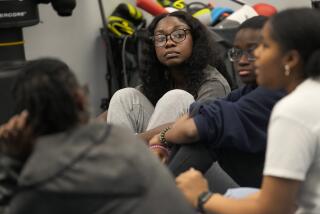A minor hue and cry over a practical way to explain color to the colorblind
- Share via
Fallon Evans, who calls himself the “designated hitter” in the English Department at Loyola Marymount University, occasionally writes to me to express ideas that are not easy to express.
Recently he wrote that he is colorblind, and he wondered what the world looked like to a person who isn’t colorblind.
Since I don’t know what the world looks like to a person who is colorblind, I don’t know the difference, and I can’t help him.
Evans didn’t know that he was colorblind until he tried to join the Navy at 18. That was during the war and he was hoping to evade the draft.
“I wanted to join one of those fancy programs that would send me to college and graduate me as an ensign,” he confesses.
At the recruiting station he was found fit enough until a yeoman 3rd class presented him with one of those charts with “large circles of colored dots that are reputed to have numbers embedded in the dots.”
“What number do you see here?” the yeoman asked.
“I don’t see any number, sir,” Evans said.
“Don’t call me sir, mister.”
“Sorry, sir.”
The yeoman went to another chart. “What number do you see here, wise guy?”
“I don’t see any number at all.”
Evans was drafted by the Army, which didn’t care if you were colorblind. In fact, the Army thought it might be an asset.
“I was picked to be an artillery observer. It occurred to someone that colorblind people might be able to detect enemy camouflage.”
He was sent aloft in a Piper Cub to observe. The pilot left the windows open to facilitate his observations.
“When he pointed dramatically down, signifying that we were over camouflaged artillery, I looked straight down and had my first grasp of existential meaninglessness.” (He was ahead of Sartre.)
Evans threw up.
And it went into his record that he suffered from vertigo as well as colorblindness.
My own brother had a similar experience with a much happier ending. Like Evans, when the war came he applied for a Navy commission, perhaps to avoid being drafted. Like Evans, he had no idea he was colorblind.
And he, too, failed the colorblind tests. But, instead of being rejected, he was accepted, was sent to college for officer training, and emerged an ensign. Perhaps it was because he hadn’t been flip with a yeoman 3rd class.
Not only was he made an ensign in the Navy, he was made a signal officer--and had to learn the meaning of all those little colored flags by which ships communicate when radios are silenced. Given his handicap, I don’t know how he did it. But he ended up on an admiral’s staff in the South Pacific and had a distinguished career.
Perhaps one reason my brother survived as a colorblind signal officer was that he was also in charge of liquor procurement for his officer’s mess. In this capacity he often wangled high-priority air transport to various bases in the South Pacific where he could obtain large supplies of liquor.
In war, one does what one can.
While we’re on the subject of color, we might consider a question posed by E. S. Bertolini of Venice. He writes that in 1965 his English professor assigned his class to write a one-page description of any color they wished to a blind person. After two sleepless nights, he says, he decided to describe the color yellow. His essay, in part:
“You say you’re blind since birth and wish that I describe to you the color yellow? But I already know that though you are without sight, you are not without vision; you will be able to grasp the meaning of all colors better than he who has sight, but never had vision.
“I will tell you about the child who wore a yellow dress, and matching yellow socks, and walking down the street was swinging to the rhythm of her step a tiny yellow bag. My eyes were filled with that one color, and all sensations that I have, were cramped into the one I call my sight, and it saw only yellow.
“But then I tell you: ‘There’s a child across the street, who’s wearing yellow to her feet.’ All your sensations begin to race, to float, to run asunder in search for things, and feelings, and familiar images, which will make your picture more complete.
“You recall the day you left the building, and wished to cross to the other side, but froze with fear because the noise you heard, you knew would kill, if you proceeded. Then an elbow nudged you on your arm, and you heard her gentle voice repeat: ‘Let’s hurry, or that yellow truck will run us over,’ and you took her hand, and missed the truck of death, which she called yellow.
“My sight has limited my vision to one shade of yellow when I saw the little girl; but your vision sees all hues and colors and recalls the many things that tell you what the color really means.”
Bertolini says the professor gave him an A-plus.
I don’t know. I grant that his little essay is imaginative and poignant, but I don’t believe that a person who has never seen color can have any concept of color.
Color can be described only in terms of color.
And how can the fear of a truck color one’s vision of a little girl in a yellow dress?
Meanwhile, you know how Evans responds to traffic lights? Easy. Top means stop.
More to Read
Get our high school sports newsletter
Prep Rally is devoted to the SoCal high school sports experience, bringing you scores, stories and a behind-the-scenes look at what makes prep sports so popular.
You may occasionally receive promotional content from the Los Angeles Times.






